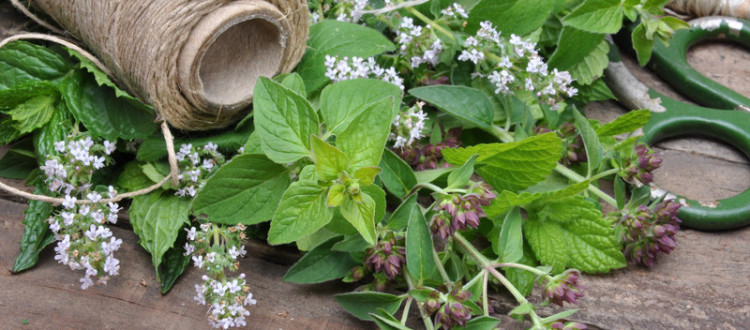How to Harvest and Dry Herbs
Extend the summer flavor of home-grown fresh herbs by drying them for use over the winter. Drying herbs is easy, and just takes some scissors, twine, and a little time.
As your fantastically vigorous herb bed flourishes, there will be times you will need to cut back your herbs for the health of the bed in order to maintain good sun exposure and improve air circulation. Otherwise, the plants may begin to show signs of flowering, which is when the highest amount of essential oils is in the leaves. In this case, you want to cut your herbs back to promote more foliage growth.
Midsummer and early fall are both good times to cut back your herbs. This will also increase your harvest over the length of the season. As the days grow longer, plants get the signal to send out roots, shoots, and leaves. The Summer Solstice, the longest day of the year, is the turning point when the days begin to shorten. This also sends a message to plants that it is time to turn its energy from growing foliage to producing flowers. Flowering causes seed to be produced, ensuring its continued existence.
It was once believed that herbs harvested on “midsummer’s day” (the solstice) were more potent and imbued with special healing properties due to the leaves having the highest oil content. Medicinal herbs were collected before the high temperatures of summer burned off these essential oils.
Harvesting Herbs
The best time to harvest herbs is in the morning, as soon as possible, when the highest amounts of essential oils are present. Others prefer to harvest herbs after the dew is off the leaves. Whichever time you choose, harvest herbs as early as possible.
Cut back the plant liberally in the summer to stimulate growth. The longer stems make it easier to create nice bunches. In the fall, you need to be more judicious about cutting back too severely. Done correctly, you will be rewarded with another flush of growth before the plant slows down or goes dormant.
Drying Herbs
Herbs which have a low level of moisture in their leaves and stems dry readily when tied into bunches and hung in a dark dry place with good air circulation. An empty closet is ideal. (Okay, now go empty out that closet!)
Trim off some of the lower leaves and use about 6-10 stalks per bunch. Herbs that dry well this way include oregano, thyme, marjoram, rosemary, and sage. Parsley and tarragon dry well this way, too, but you’ll need to use fewer stalks per bunch and to tie the bunches so that the leaves are not bunched up and monitor them closely for mold and mildew.
During the summer months, herbs will dry in about 3-4 weeks. If you have problem with dust, you can place the herb bundles in paper bags or muslin with lots of holes cut in them for air circulation. It’s a little extra work, but it is nice to keep the dust off. Otherwise, just be sure to put the herbs in jars as soon as they are dry so they collect as little dust as possible.
Large leaved herbs with more moisture can be dried in a dehydrator or air dried on a screen. Lay cheesecloth on the screen beforehand, and add another layer on top if you have a real dust problem. Herbs can also be dried in an oven, but you have to stay on top of it. 100° is the optimum drying temperature, but most ovens can’t be set that low. It is also good to rearrange the leaves every half hour or so to hasten uniform drying.
Basil, mints, chives, cilantro, lemongrass and (parsley and tarragon too, if you have trouble air drying them) can also be dried in a microwave or in a refrigerator, but I won’t go into that here. Although I haven’t tried drying herbs in the refrigerator, I know mine doesn’t have enough room, and I am not sure what flavors the herbs might pick up!
Storage
After storing the whole leaves in the jars, watch them closely for the next few days for any water droplets that can lead to mildew, rendering your herbs useless. If you catch it right away, you can take them out of the jar and finish drying them.
Label your jars with the herb name and date. If you have some special blends you use a lot, you can create your own and customize it. Herb blends make wonderful gifts —make sure you include “homegrown” on the label and give it a fun name like “Suzie’s Saucy Spaghetti Sauce Stuff “ or some such!
Rubs are really popular now too, and with the additional kosher salt, it stretches your harvest even further! Rubs are also a good way to introduce your dried chiles into the mix!
Here is a blend that my mom used quite a bit that doesn’t seem to be available any more. Use it with chicken, fish, eggs and veggies.
Fines Herbes
Fines herbes is a fragrant, classic French blend of four, delicate but distinctive herbs. Some times this blend includes sweet marjoram. Since the flavors are so delicate, using these fresh is another option.
Combine equal parts of the following dried herbs:
Parsley
Chives
Chervil
Tarragon
Sweet Marjoram, if desired
Place all the ingredients into a non-reactive bowl and gently mix. Store in airtight jar. Be sure to crush the leaves as you use them in order to release the full flavor of the oils in the dried leaves. Fine herbes blend is used with chicken, fish, eggs, in a creamy salad dressings or vinaigrette. It also adds flavor to breading or stuffing.

